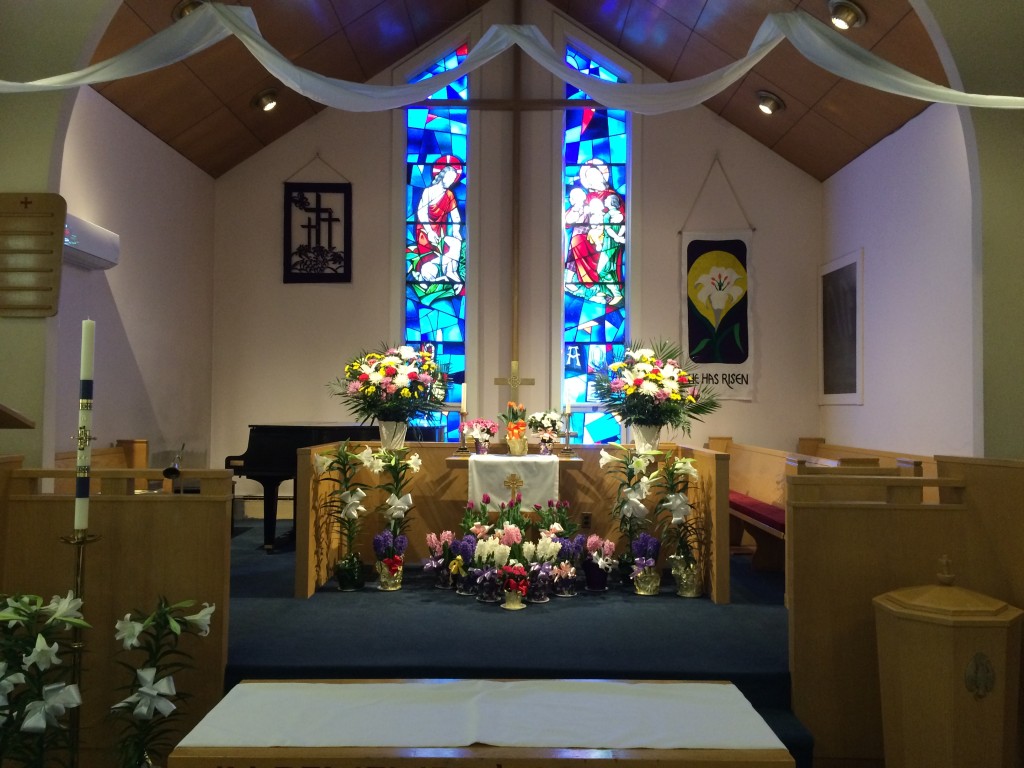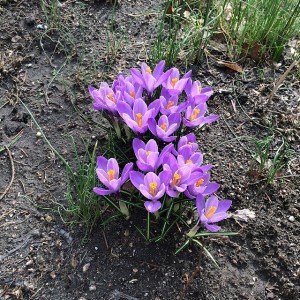a sermon on Luke 24:1-12
preached on Easter Sunday, March 27, 2016, at the First Presbyterian Church of Whitestone

Why do you look for the living among the dead?
This strange question surely startled the women who had come to the tomb on that first Easter morning. After all, they were looking for a dead man. They had watched with their own eyes as Jesus had been executed just two days earlier. They had seen the tomb and how his body was laid there by Joseph of Arimathea. They knew that Jesus, their friend and teacher, was dead. So when they showed up on that Sunday morning to find the stone rolled away and his body missing, they knew that something was up, but nothing was resolved by two men telling them that they were looking in the wrong place!
Why do you look for the living among the dead?
This strange question from two men in dazzling clothes at the tomb set the stage for everything that followed. “He is not here, but has risen,” they announced. This was strange, unexpected news—while Jesus had told them that this would be coming, even these very faithful women had forgotten about it. Their sabbath day had been filled with mourning for their friend, with preparing spices and ointments for the time when they would offer their final respects to his body, with all the other things that needed to be done when a good friend dies, and they had forgotten that this might not have been the end of the story for Jesus after all. It took these two men in dazzling clothes to jog their memory a bit, to remind them that Jesus had told them “that the Son of Man must be handed over to sinners, and be crucified, and on the third day rise again.” But as soon as they remembered, they saw only that their search for Jesus had just begun.
Why do you look for the living among the dead?
After being confronted with this strange question and reminded that Jesus had told them that this would not be the end of the story, the women started to think about where Jesus might be. So they made their way back to the other disciples, to the core group of men who had journeyed with him along the way, hoping that these other friends might join them in sorting out what was next. But the disciples thought all this an “idle tale” and dismissed this word outright. Jesus was dead, and they knew it. They had seen it for themselves, and the strange rantings of some women about a missing body were nothing more than rumors of grave robbers. Peter was the only one who even thought this report was worthy of investigation, but even when he found the tomb empty except for the linen cloths that had wrapped Jesus’ body, he went home in amazement.
This first proclamation of the resurrection ends with no report of Jesus actually being seen alive and only a vague hope that this story would end with anything more than an empty tomb and a missing body. The search for Jesus ended before it ever really began—it seems that they really did know only how to look for the living among the dead.
Why do you look for the living among the dead?
This strange question first posed to the women on that Easter morning echoes across the ages to us, too. It is quite fitting that one of the abiding traditions of this day is the Easter egg hunt, when we seek out hidden things, for the good news of the resurrection on this Easter Day demands that we seek the risen Christ in our world.
But this search inevitably leads us to the same places as the women and the disciples, looking for the living among the dead. Have we gone to the tombs of our world—the old ways of doing things, the memories of past glory, the preserved remains of days long since gone—expecting to find new life? Who have we met when we have gone there? Have any “men in dazzling clothes” helped to point us in a different direction? Or have the main people we have encountered along the way told us that our reports of new life are nothing more than an “idle tale?” Some days we may be better at seeking Jesus out in our world than others—some Easter egg hunts are easier than others, after all!—but it is so easy to end up with the women and the disciples, looking for the living among the dead.
Why do you look for the living among the dead?
The search for the living Christ in our midst isn’t always easy, after all. First, we have to get past the death and destruction and darkness that surround us. We certainly must mourn the pain and hurt of our lives and our world. We cannot ignore the realities of fear and anxiety that creep insidiously into our lives day after day, building up as reports of terrorism and death swirl around us, taking hold as too many who lead us or seek to lead us seize on our fears to exclude some of God’s beloved children from the fullness of God’s care and protection. And we cannot ignore the tragedies that strike our lives in ways and times that we least expect that force us to reorient ourselves to a different way of life.
Faced with all these moments of death, surrounded by destruction and darkness, it is difficult to imagine where we might look for new life. So when we do decide that we want to set out on the journey to find the risen Jesus, we tend to go looking for him in the places we know best, where we have seen him before, where life is comfortable and simple, where new life bursts forth in grand and glorious moments with loud trumpets and bold proclamations.
But if the experience of the women and the disciples is any guide, we are likely to be left wandering if we look only here. Instead, our search for Jesus must take us to some different kinds of places along the way. We might need to go some places we have not been before. We might need to seek out places where there is life abundant, places where people are showing care and love for one another, places where the barriers of this world are being broken down and we are invited to live together in new ways, places where light quietly and slowly—yet surely—streams into darkness to make it clear that death will never have the final word. We might need to seek out Jesus among those he called “the least of these”—among the poor and outcast, among the hungry and thirsty, among strangers and refugees and prisoners, among all who are rejected and despised by the world and so are especially made welcome by God. And in our search for the risen Christ in our world, we might need to make our way to this table, to this place where Luke tells us the disciples finally met him alive again, where their eyes were opened and they recognized him in the breaking of bread.
Why do you look for the living among the dead?
Friends, as we seek the risen Christ in these Easter days, may God guide us to look for the living among the living, to open our eyes to the places and ways that Jesus is alive in our world where we might least expect it, to walk in our world in ways that show that death does not and will not have the final word, and to serve in love so that all can see the risen Christ among us as we offer his hope to those in greatest need, until he comes again in glory and all creation joins in his resurrection life forever and ever.
Christ is risen! He is risen indeed! Alleluia! Amen.
